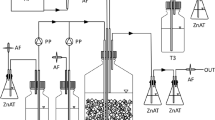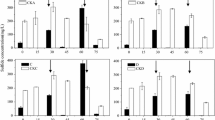Abstruct
A project is under way at the University of Tulsa to investigate the reduction of SO2 to H2S by sulfate reducing bacteria (SRB) in co-culture with mixed fermentative heterotrophs. We have previously demonstrated that SO2 is completely reduced to H2S (contact times of 1–2 s) in cultures in which no redox poising agents were required and glucose served as the ultimate source of carbon energy. We have proposed that such a microbial process could be coupled with a Claus reactor to recover elemental sulfur as a byproduct of regenerable, dry scrubbing processes for flue gas desulfurization. The development of this process concept has continued with a study of the use of molasses as a source of carbon and reduced nitrogen, identification of important non-SRB heterotrophs in process cultures, and the identification of the end products of carbohydrate fermentation that serve as carbon and energy sources for the SRB and identification of the end products of SRB metabolism.
Similar content being viewed by others
Reference
Guderian, R. and Stratmann, H.(1968),Forschungsbeerichte des Landes Nordrhein-Westfalen,1920, 114.
Linzon, S. N.(1971),J. Air Poll. Contr. Assoc. 21, 81.
Coffin, D. L. and Knelson, J. H.(1977), Federal Power Commission Report, II-6-26.
Amdur, M. O. and Underhill, D.(1968),Environ. Health 16, 460.
Drummond, C. J., Yeh, J. T., Joubert, J. I., and Ratafia-Brown, J. A. (1985),78th Annual Meeting & Exhibition of the Air Pollution Control Association.
Yeh, J. T., Drummond, C. J., Halsbeck, J. L., and Neal, L. G.(1987),AIChE Spring National Meeting, Houston, TX.
Dasu, B. N. and Sublette, K. L.(1989),Biotech. and Bioeng. 34, 405.
Postgate, J. R.(1984),The Sulfate Reducing Bacteria, 2nd ed., Cambridge University Press, Cambridge, UK.
Maddox, R.N. (1974),Cas and Liquid Sweetening, Campbell Petroleum Series, Norman, OK.
Campbell, J. M. (1978),Gas conditioning and Processing, Campbell Petroleum Series, Norman, OK.
Dasu, B. N. and Sublette, K. L. (1989),Appl. Biochem. Biotech. 20/21, 207.
Clark, J. M. ed. (1964),Experimental Biochemistry, W. H. Freeman, San Francisco, CA.
Nelson, N.(1944),J. Biol. Chem. 153, 375.
Merrick-Glass, M. T. (1986),American Clinical Products.
Miller, L. and Berger, T. (1985),Hewlett-Packard Gas Chromatography Application Note 228–41.
Atkinson, B. and Mavituna, F. (1983),Biochemical Engineering and Biotechnology Handbook, Nature Press, New York.
Buchanan, R. E. and Gibbons, N. E. eds. (1974),Bergey’s Manual of Determinative Bacteriology, 8th ed., Williams and Wilkins, Baltimore, MD.
Author information
Authors and Affiliations
Rights and permissions
About this article
Cite this article
Plumb, P., Lee, K.H. & Sublette, K.L. Microbial reduction of SO2 as a means of byproduct recovery from regenerable, dry scrubbing processes for flue gas desulfurization. Appl Biochem Biotechnol 24, 785–797 (1990). https://doi.org/10.1007/BF02920295
Issue Date:
DOI: https://doi.org/10.1007/BF02920295




